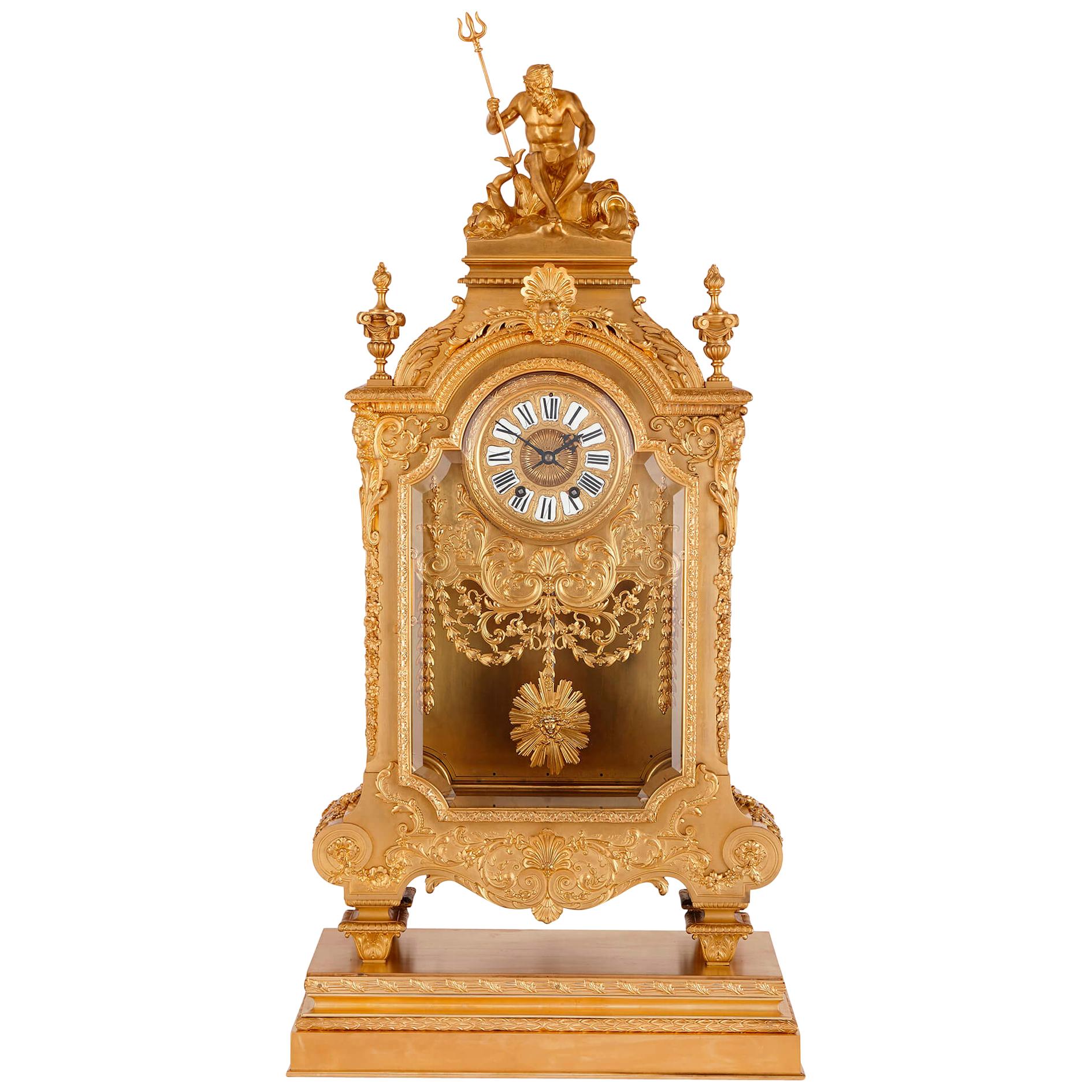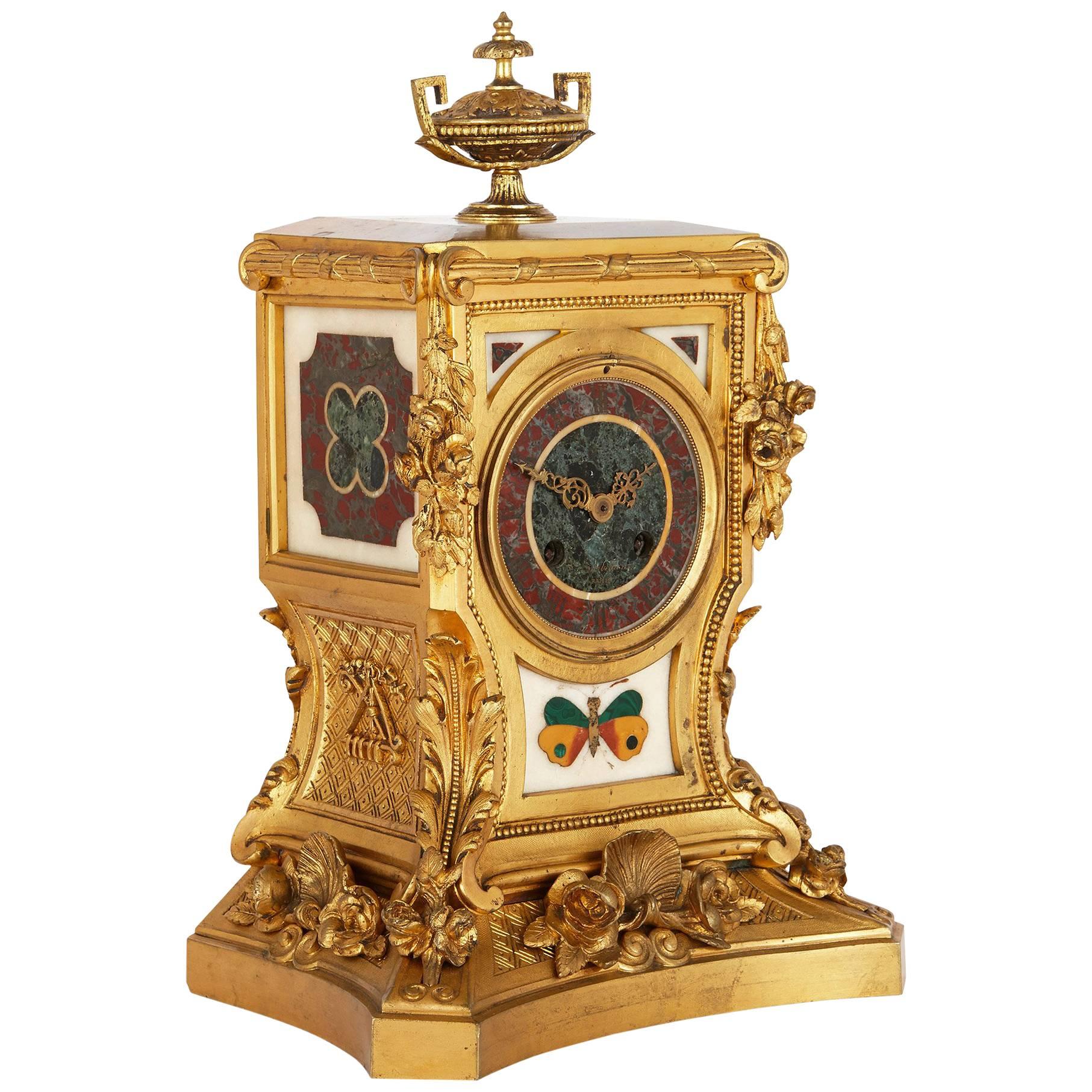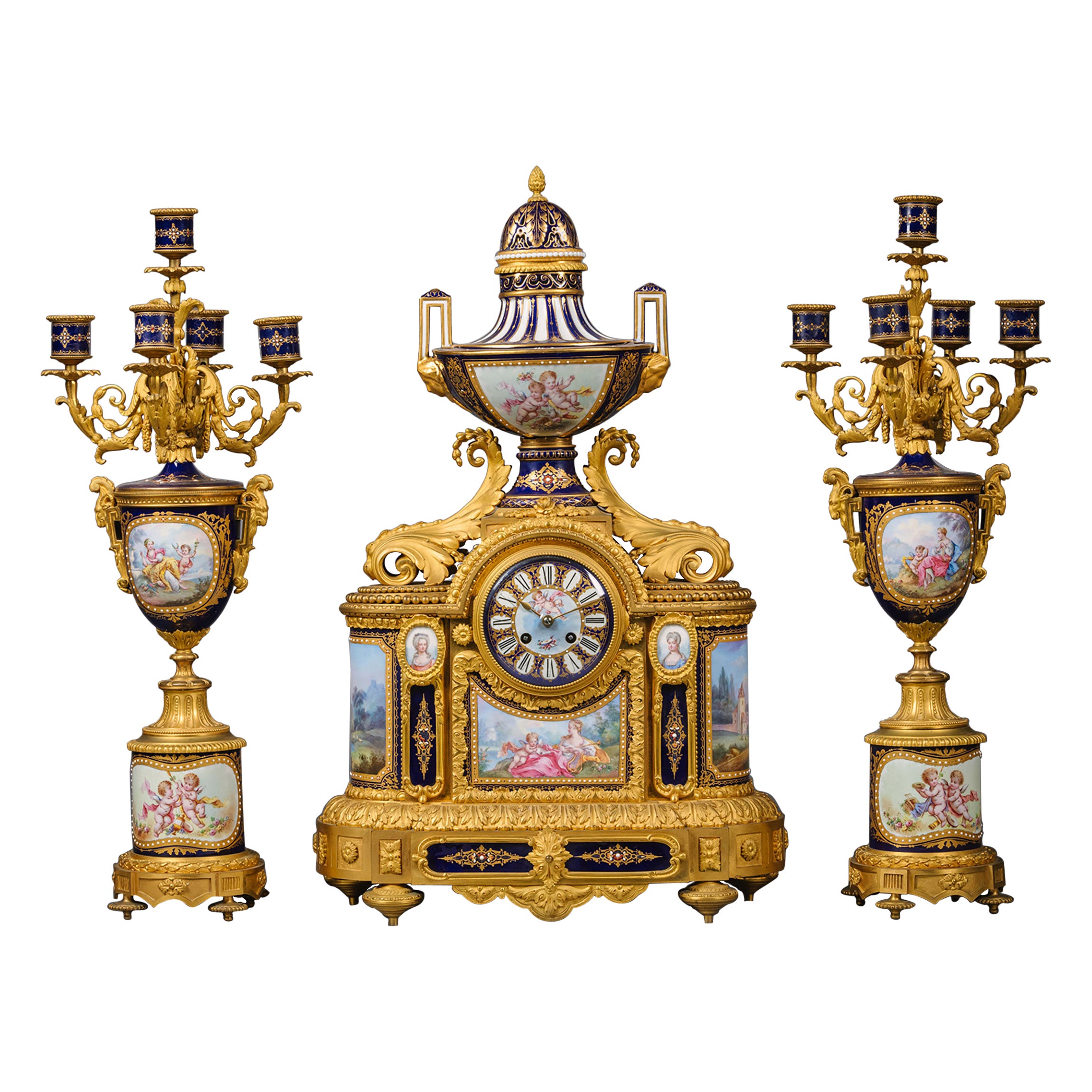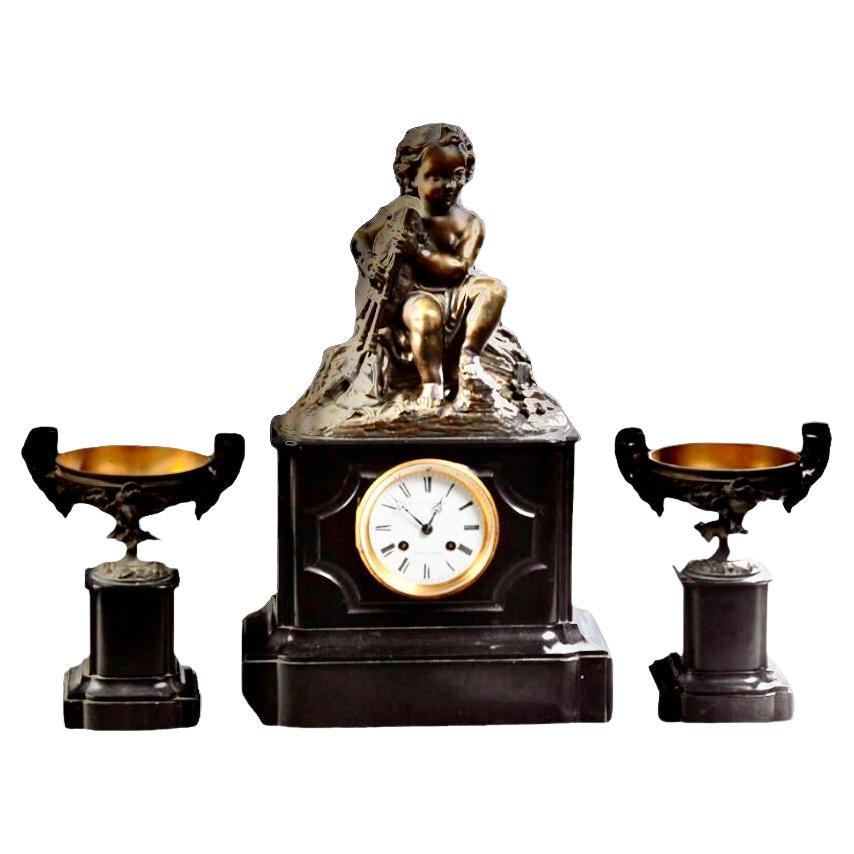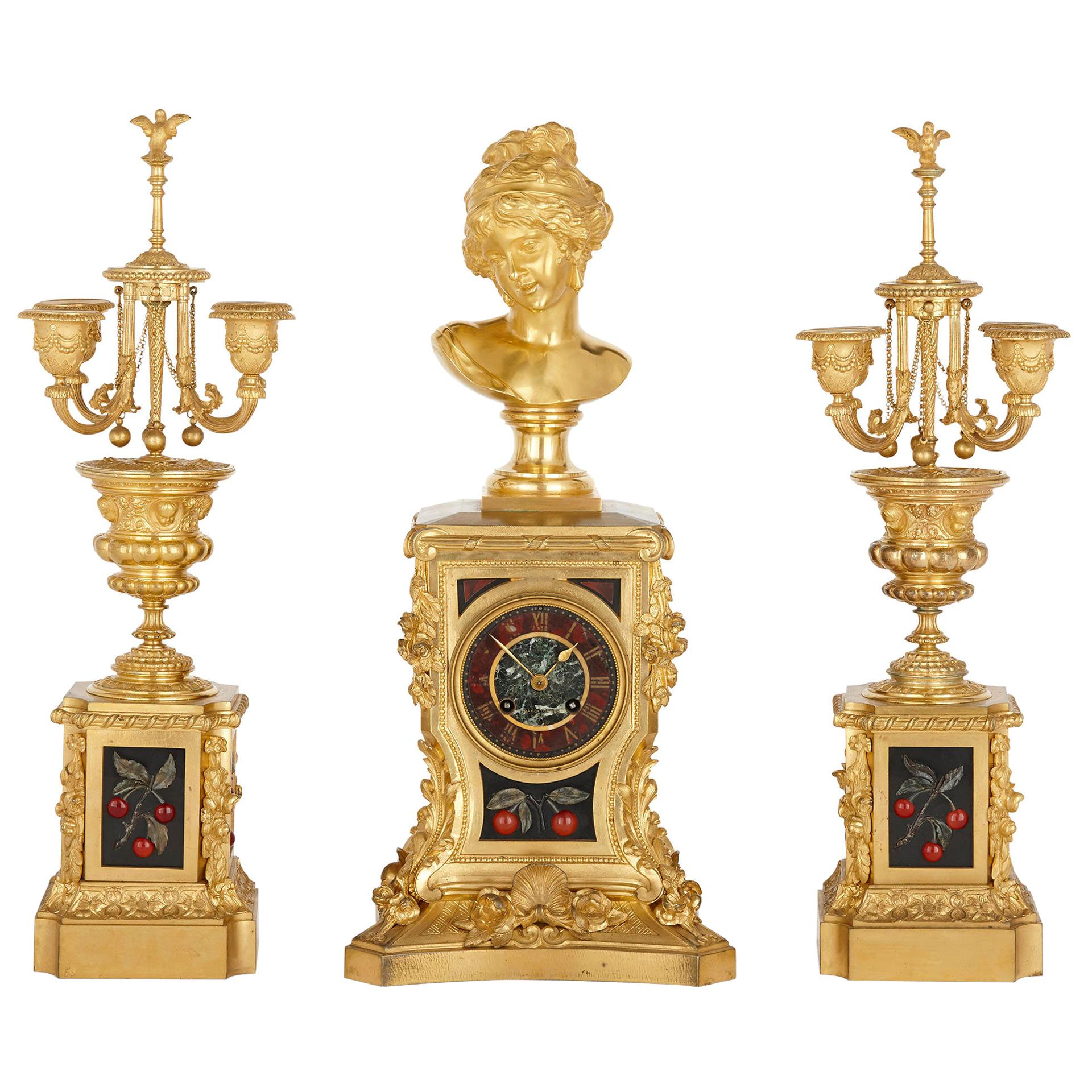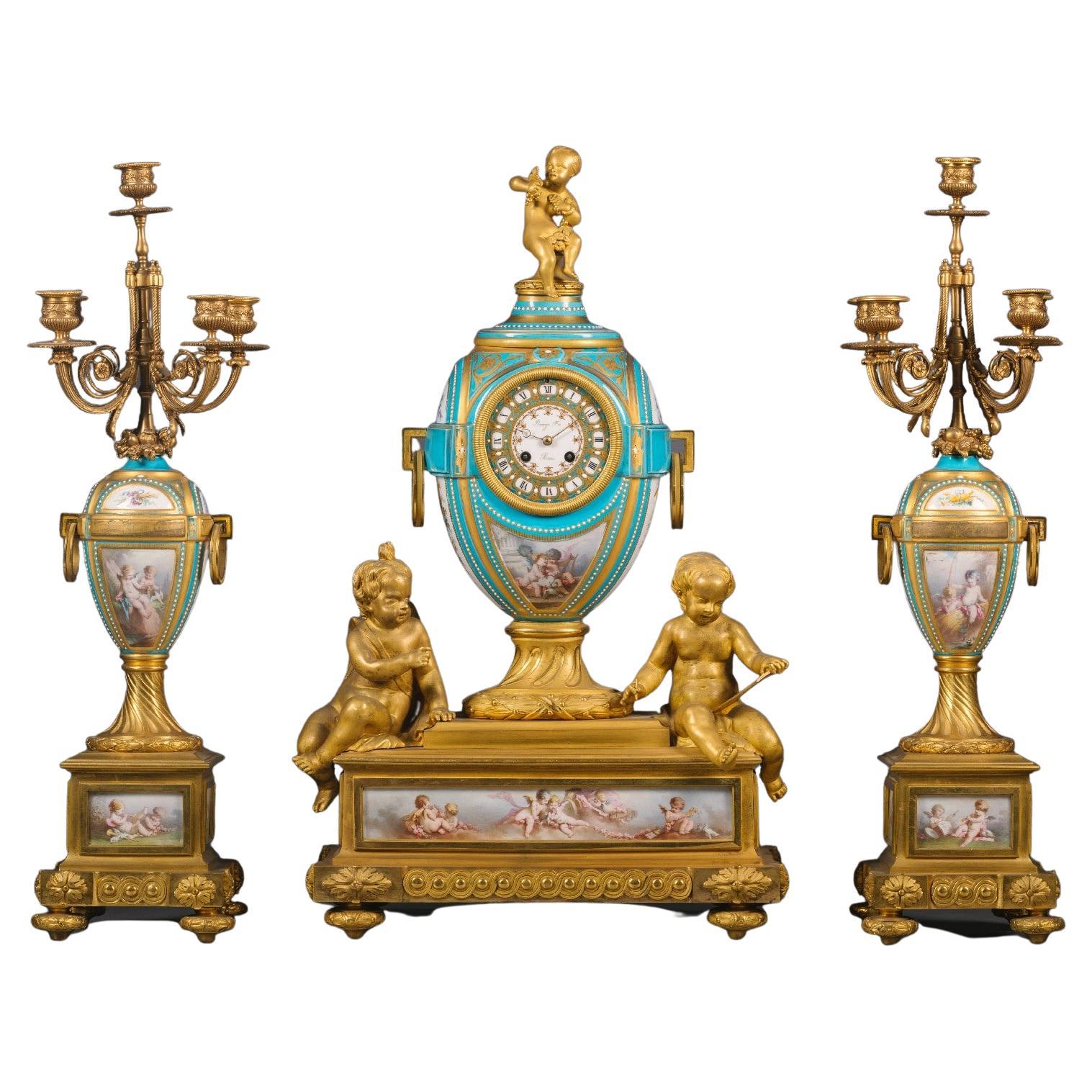Items Similar to Napoleon III Clock Garniture Designed by Sévin, Cast by Barbedienne
Want more images or videos?
Request additional images or videos from the seller
1 of 7
Napoleon III Clock Garniture Designed by Sévin, Cast by Barbedienne
About the Item
A fine Napoleon III gilt-bronze and porcelain mounted clock garniture, designed by Louis-Constant Sévin, cast by Ferdinand Barbedienne, The Movement by Japy Frères.
Frédéric Japy (1749-1812) was apprenticed in Montbeliard to his clockmaker uncle, and returned to his home town of Beaucort, setting up as a clockmaker, and an organiser of local clockmakers into a company - the company expanded and were medal winners at many of the International Exhibitions throughout the 19th century under the aegis of his sons, eventually closing after the First World War.
French, circa 1870.
Ferdinand Barbedienne (1810-1892) was the inspiration and driving force behind one of the most important French art foundries. He pioneered the use of mounts and, more commonly, bronze sculpture including figures and animals. Barbedienne produced catalogues of bronze reproductions of Greek and Roman classical sculpture and experimented with champlevé and cloisonné enamels during the third quarter of the century. Barbedienne exhibited several pieces of furniture at the 1855 Paris Exhibition including an ormolu mounted oak dressing table and an ormolu mounted ebony veneered bookcase. Both pieces were executed in his favoured Renaissance revival style for furniture. Furniture with mounts signed by Barbedienne is extremely rare.
The Barbedienne foundry handled the casting of numerous national monuments and architectural schemes. Ferdinand Barbedienne himself also took an active part in the promotion of contemporary sculpture and became one of the founders for David d'Angers' medallions as well as much of Rude's sculpture.
His signature varied from hand written capitals to stamp in capitals, usually 'F. Barbedienne, Fondeur' or 'BARBEDIENNE PARIS'.
In 1839 Barbedienne collaborated with the inventor Achille Collas who had succeeded in enlarging and reducing works of art to arbitrary sizes by a simple mathematical calculation, allowing the accurate reduction of classical and contemporary marbles for the purpose of reproduction in bronze. In 1850 Barbedienne was commissioned to furnish the Paris town hall for which he was awarded with the médaille d'honneur at the Paris Exposition Universelle in 1855.
Bibliography:
Barbedienne, Ferdinand. Catalogue des Bronzes d'art 1886.
Fonderie d'art Français: Val d'Osne, Fonderie de Tusey, Antoine-Louis Barye, Fonderie Rudier, Charles Crozatier, Ferdinand Barbedienne' Livres Groupe, (Paris), 2010.
Louis-Constant Sévin (1821-1888) was one of the most important French ornamental sculptors of the second half of the nineteenth century. He began his training at the early age of thirteen, when in 1834 he was apprenticed to the Parisian sculptor Antoine-André Marneuf. In 1839 he left Marneuf in order to join forces with the sculptors Phénix and Joyau, with whom he began designing objects for famous silversmiths including François-Désiré Froment-Meurice, Jean-Valentin Morel and Henri Duponchel.
He fled to London during the 1848 Revolution and there worked at Morel’s recently opened studio on New Burlington Street. Under Morel’s auspices, Sévin designed many pieces that were presented at The Great Exhibition of 1851. Returning to France in 1851, he began designing porcelain models for the factories of Jouhanneaud and Dubois in Limoges, many of which featured at Paris’s 1855 Exposition Universelle.
In 1855, Sévin took the position of ‘sculpteur-ornamentiste’ with Ferdinand Barbedienne (1810-1892), who had established one of the most highly esteemed bronze casting foundries of the nineteenth century. Sévin was to spend the remaining twenty-three years of his life there providing plans and instruction to the company’s craftsmen. Executing over two thousand designs in this time and often using novel techniques, his objects were some of the most stylistically diverse and innovative in the Barbedienne foundry and indeed in the wider production of decorative arts in France.
Sévin regularly received commissions from European nobility and royalty, and his pieces were frequently displayed at the Great International Exhibitions of the period. His most prestigious commissions include his work for the chapel and tomb of Prince Albert at Frogmore House in Windsor, his bronze work at the Hôtel de la Païva in Paris, and the candelabras designed for the Kremlin. He was to achieve great recognition in his own time and was awarded many medals for artistic excellence.
- Creator:Louis-Constant Sevin (Designer)
- Attributed to:F. Barbedienne Foundry (Maker)
- Dimensions:Height: 17.72 in (45 cm)Width: 16.54 in (42 cm)Depth: 7.09 in (18 cm)
- Sold As:Set of 3
- Style:Napoleon III (Of the Period)
- Materials and Techniques:
- Place of Origin:
- Period:
- Date of Manufacture:circa 1870
- Condition:Wear consistent with age and use. The movement is in running order with the strikework functioning as it should when tested. We cannot however guarentee the movement or any mechanical operation following shipping and therefore recommend getting it overhauled by a clock restorer.
- Seller Location:Brighton, GB
- Reference Number:
About the Seller
5.0
Recognized Seller
These prestigious sellers are industry leaders and represent the highest echelon for item quality and design.
Established in 1964
1stDibs seller since 2014
48 sales on 1stDibs
Typical response time: 1 hour
Associations
The British Antique Dealers' AssociationLAPADA - The Association of Arts & Antiques Dealers
- ShippingRetrieving quote...Ships From: Brighton, United Kingdom
- Return PolicyA return for this item may be initiated within 7 days of delivery.
More From This SellerView All
- Napoléon III Sèvres Style Clock GarnitureLocated in Brighton, West SussexA fine Napoléon III gilt-bronze and sèvres style cobalt blue ground 'Jewelled' Porcelain Three-Piece Clock Garniture Comprising a mantel clock and a pair of five-light vase candel...Category
Antique 19th Century French Napoleon III Mantel Clocks
MaterialsOrmolu
- Napoleon III Gilt Bronze and Porcelain Three Piece Clock GarnitureBy Raingo FrèresLocated in Brighton, West SussexA fine Napoleon III gilt bronze and porcelain three piece clock garniture by Raingo Freres. The circular gilt and 'jewel' decorated porcelain dial of the clock with Roman numerals an...Category
Antique 19th Century French Napoleon III Mantel Clocks
MaterialsOrmolu
- Fine Napoléon III Gilt-Bronze Mounted Porcelain Clock Garniture, circa 1870Located in Brighton, West SussexA fine Napoléon III gilt-bronze mounted porcelain clock garniture. French, circa 1870. The movement stamped with the 'Japy Frères ' cachet. This fine porcelain clock set is...Category
Antique Late 19th Century French Napoleon III Mantel Clocks
MaterialsBronze
- Important Napoléon III Gilt-Bronze and Porcelain Clock Garniture, circa 1870Located in Brighton, West SussexAn important Napoléon III gilt bronze and turquoise porcelain clock garniture. French, circa 1870. This very fine clock garniture comprises of a clock and a pair of vase form candelabra. The finely cast and chiselled gilt bronze case has a jewelled turquoise porcelain face with Roman Numerals above a plaque depicting children in a wooded landscape, flanked by expressive male and female cherub figures, cast in the round, beneath a scrolled pediment with torches en flambeau and surmounted by a turquoise vase and cover. The pair of candelabra en-suite are in the form of turquoise porcelain vases...Category
Antique Late 19th Century French Napoleon III Mantel Clocks
MaterialsBronze
- A Napoléon III Marble Mantle ClockBy J. PradierLocated in Brighton, West SussexA Napoléon III Marble Mantle Clock With A Patinated Bronze Figure of 'Phryné' by James Pradier. France, Circa 1860. Surmounted by a finely cast pa...Category
Antique 19th Century French Napoleon III Mantel Clocks
MaterialsGriotte Marble, Bronze
- Napoléon III Gilt-Bronze Double-Faced Clock. French, c 1870By Julien Le RoyLocated in Brighton, West SussexA rare Napoléon III gilt bronze double-faced clock. The white enameled dial signed 'Julien Le Roy A PARIS'. This rare Rococo style figural clock h...Category
Antique Late 19th Century French Napoleon III Table Clocks and Desk Clocks
MaterialsBronze
You May Also Like
- Antique Gilt Bronze Mantel Clock by Sevin and BarbedienneBy Louis-Constant Sevin, Ferdinand BarbedienneLocated in London, GBThis ormolu clock is an exemplary work by the famous French 19th century metalworker and foundry-owner, Ferdiand Barbedienne. Working with a design made by the acclaimed onamentalist, Louis-Constant...Category
Antique Late 19th Century French Neoclassical Mantel Clocks
MaterialsOrmolu, Bronze
- Napoleon III Period Mantel Clock by BarbedienneBy Ferdinand BarbedienneLocated in London, GBThis stunning clock expertly showcases the ingenuity of its maker, Ferdinand Barbedienne, and its smart styling in the opulent Napoleon III style will make it an excellent addition t...Category
Antique 19th Century French Napoleon III Mantel Clocks
MaterialsMalachite, Marble, Bronze, Ormolu
- French, Napoleon III Bronze and Marble Clock Garniture, C. 1880Located in New Orleans, LAAn outstanding Antique French Napoleon III three piece bronze and marble clock garniture set, c. 1880, with a bronze surmount of a putto playing a bagpipe, over a drum clock...Category
Antique Late 19th Century French Napoleon III Mantel Clocks
MaterialsMarble, Brass, Bronze
- Gilt Bronze and Hardstone Inlay Napoleon III Period Clock Set by BarbedienneBy Ferdinand BarbedienneLocated in London, GBGilt bronze and hardstone inlay Napoleon III period clock set by Barbedienne French, 19th century Measures: Clock: Height 50cm, width 23cm, depth 16c...Category
Antique 19th Century French Napoleon III Mantel Clocks
MaterialsStone, Bronze, Ormolu
- 19th Century AD Mougin Parisian Napoleon III Clock & Garniture SetBy A.D. MouginLocated in Forney, TXA magnificent, large, and original, French three piece mantel set from the late 19th century. The Napoleon III Second Empire period, Neoclassical style antique clock having an urn form finial with sculptural gilded bronze mounts, over architectural case made of the most beautiful variegated specimen marble, with various shades of salmon pink and white, black and silver veining, pierced flower blossom ormolu mounted columns flank the hand enameled fancy dial with Provincial figural scene, signed Guinchard & Martin, Castres, glass door with beaded gilt brass bezel, housing the high-quality eight day time and strike movement stamped AD Mougin...Category
Antique Late 19th Century French Napoleon III Mantel Clocks
MaterialsMarble, Brass, Bronze, Ormolu
- 19th Century Bronze Three Piece Garniture Clock Set by BarbedienneBy Ferdinand BarbedienneLocated in Los Angeles, CAUnusual monumental clock set in Griotte marble signed Barbedienne and on the top of the clock you have a bronze made by one of the famous bronze m...Category
Antique Late 19th Century French Napoleon III Mantel Clocks
MaterialsGriotte Marble, Bronze, Ormolu
Recently Viewed
View AllMore Ways To Browse
Antique By Design
Antique Sign Designs
Foundry Sign
Napoleon Signed
Antique Clock Designs
Manyal Clocks
Foundry Castings
Antique House Architectural Design
Architectural Design Of Antique House
Charles Iii Furniture
World Time Clock
Early Napoleon Iii
Display Clock
Studio F
European Antique Clocks
Antique Napoleon Clock
Napoleon Clock Antique Clocks
Napoleon Clocks Antique
